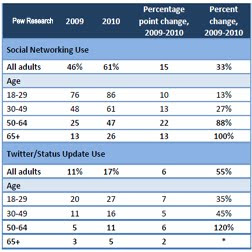
"My words fly up, my thoughts remain below: Words without thoughts never to heaven go." — Hamlet (III, iii, 100-103)
When social media turns serious, it strikes me as silly. It doesn't mean there isn't any value in the communication being offered. Although sometimes, with furled brows and lessons to be taught, that is the way communication plays out as Matt Lawton reminded me yesterday.
"pls enlighten me, what is so 'silly' about the @shelholtz post It’s time for the anti-social media guru meme to die? I think u shld explain or it's rather rude." — Matt Lawton.
If you ever read his posterous blog, you'll occasionally find some funny stuff. Even on his Twitter profile, he shares to "learn and laugh." So, I played along, conveying the seriousness of the silly statement.
Really, Lawton's contribution doesn't matter so much. Shel Holtz had already contrasted my comment with one that called his post "great." Nay, I say, there is no contrast. There are as many valid points in his post as there are layers of silliness, including the notion that one can call for the death of a meme by adding to it, especially one as silly as the great guru debate has become.
Let's step back and focus on that for a moment. What's the big deal?
What's The Big Deal About The Social Media Guru Title Anyway?
As Holtz points out, when people attack the social media guru title, they are generally referring to those who have a propensity to use it — inexperienced folks with inflated egos, sleight-of-hand huskers, and whomever has a Twitter account in a room full of people who do not (they claim to be the resident experts of their little worlds).
Oh, and then there are those who are called a "social media guru" when they are introduced as Holtz says he has been. (Me too, for that matter, leaving me to make the point that I would never call myself a "guru" of anything, for a laugh.) And, of course, there are a few respected communicators who enjoy embracing the guru moniker (or, even more laughable, swami). Personally, they can call themselves lunch pail, for all I care.
However, perhaps along the way, they might enlighten themselves and appreciate that Westerners usurped these spiritual titles from the East. You do know that, right?
Originally, being a guru meant you were a Hindu or Sikh religious teacher and spiritual guide (although it is widely adopted in contemporary India with the universal meaning of the word "teacher"). The title was introduced in the West by some Eastern gurus and/or returning Westerners enlightened by the East and then was snapped up in the United States by the "New Age" movement in the 1970s.
The title "guru" quickly fell out of favor after several self-proclaimed gurus were discovered to be charlatans, cons, or even delusional. So why social media people ever thought to resurrect the soiled Western version of the word is beyond me. And now, in an attempt to be different, some want to usurp "swami" too, which perplexes me given that most Westerners would react to the title of "social media rabbi" or "social media pastor" or "social media priest" with alarmist disdain (unless they really are).
But as I said, this is no judgement of people. To each his own.
Mostly, I do think that some communicators have a distaste for "social media guru" as they do "anything guru," except as it was intended. Case in point, "plumbing guru" might score a few chuckles despite being better equipped to clear away darkness from your drain than a social media guru can light your way toward embracing social media.
"This being the case, just who are these anti-guru posts aimed at? It seems to me they’re mainly written by insecure practitioners trying to bolster their own egos and puffed-up prima donnas lording their superiority over their peers in the echo chamber." — Shel Holtz
Then what about those who pen anti anti-guru posts? Or this post, which I suppose is an anti anti anti-guru post? Can we take any of this seriously? I seriously hope not. There is no hypocrisy, except errant judgment about individuals as opposed to behaviors.
My world is much more simple. People are free to call themselves whatever they want. And, other people are free to respond to all those titles — mavens, masters, experts, Jedi, rock stars, bards, ninjas, thinkerbells, poodle hoopers — as they feel fit. But, at the same time, if any of these folks were truly enlightened as they claim, they would already know titles are meaningless things.
I learned that long ago, and I am still grateful for the gift. People don't relate to titles, they relate to individual people.
Besides, some communicators need the freedom of pointing out the flawed behaviors from "social media gurus" or "public relations professionals" or "personal branding experts" or "pompous journalists" in order to sometimes avoid citing specific individuals as Holtz did. It doesn't hurt anyone because anyone employing one of the more comical titles with effect already knows that the audiences they attract don't come for random titles. They come to see a person.
So that's why I called the Holtz post silly (which is a far cry from calling Holtz silly for those who embraced diatribe so quickly and DMed me to ask how dare I rub against a guru). Because, the way I see it, if I didn't find his post silly, then it would be soap boxing. I hope not. Soap boxes are ugly, which is why I find this post amazingly silly too.
Except, maybe, for the very foundation of it. There are no rules. Write what you want. Just remember, however, if you choose to call yourself the "cardinal of copywriters," it's a moniker that rightly deserves a snicker or two. All hail, you too, guru.




















